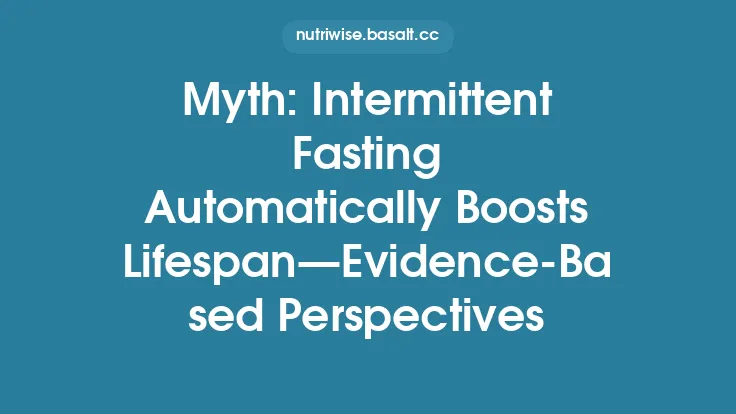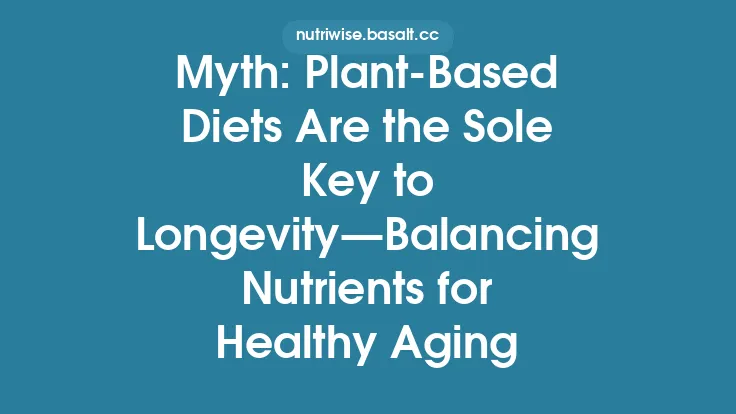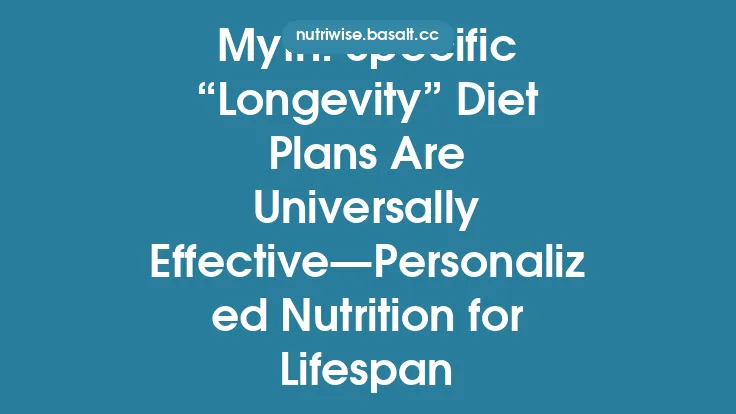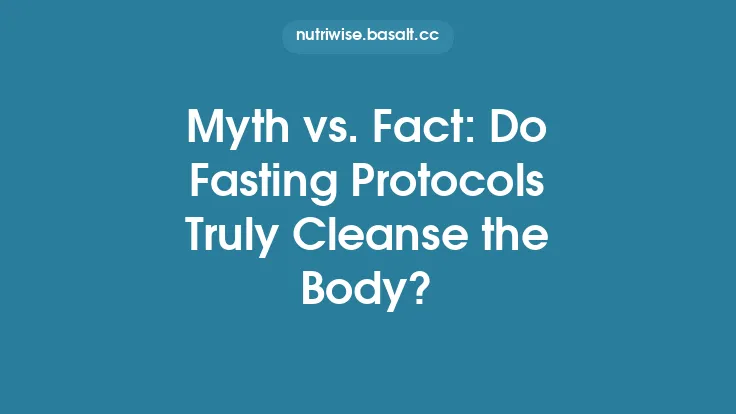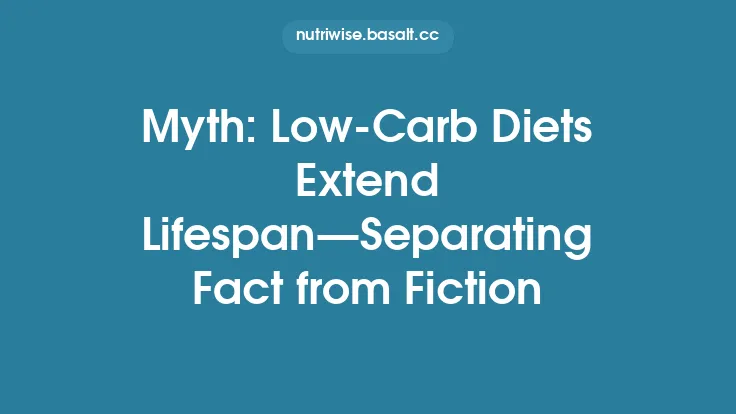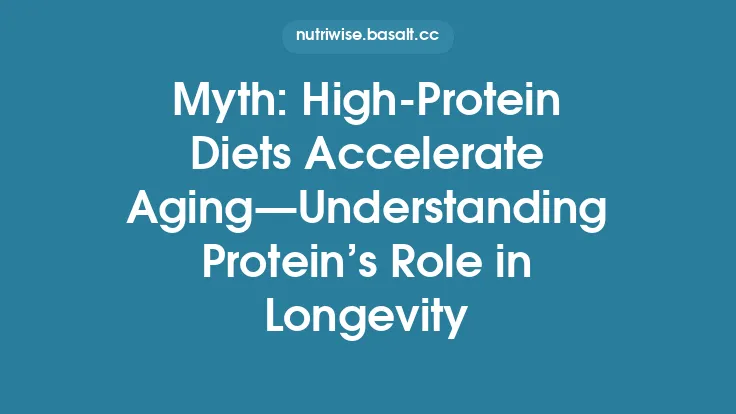Calorie restriction (CR)—the deliberate reduction of daily energy intake without causing malnutrition—has long been celebrated as a silver bullet for extending lifespan. From the early work of Roy W. Weintraub in the 1930s to the high‑profile studies of the 1990s, the idea that “eating less makes you live longer” has become a cornerstone of many longevity‑focused conversations. Yet, as the field of geroscience matures, the picture is becoming more nuanced. Modern research shows that while CR can influence biological pathways associated with aging, it is not the sole—or even the universally optimal—route to a longer, healthier life. Below we unpack the origins of the myth, examine the underlying mechanisms, review the latest human and animal data, and discuss how contemporary science is reshaping our understanding of diet, aging, and longevity.
Understanding Calorie Restriction and Its Historical Roots
The fascination with CR began with observations in laboratory rodents. In 1935, McCay and colleagues reported that rats fed 30 % fewer calories than ad libitum controls lived up to 50 % longer. This striking result sparked a wave of experiments across species—mice, flies, worms, and even non‑human primates—many of which replicated lifespan extensions under CR.
Early human interest was fueled by the “Biosphere 2” experiment and the work of researchers such as Dr. Luigi Fontana, who demonstrated that a modest 10–15 % reduction in caloric intake could improve metabolic markers in lean, healthy adults. The narrative quickly migrated from the lab to popular media, where headlines proclaimed “Eat Less, Live Longer.” The myth solidified because CR appeared to target fundamental aging processes, offering a seemingly simple, universal prescription.
Mechanisms Proposed to Link Calorie Restriction with Longevity
A wealth of molecular data supports the notion that CR modulates pathways implicated in aging. Key mechanisms include:
- Nutrient‑Sensing Pathways
- *Insulin/IGF‑1 Signaling*: Reduced caloric intake lowers circulating insulin and insulin‑like growth factor‑1 (IGF‑1), dampening downstream signaling that drives cellular proliferation and growth. In model organisms, attenuated IGF‑1 activity correlates with increased stress resistance and lifespan.
- *mTOR (Mechanistic Target of Rapamycin)*: CR suppresses mTORC1 activity, a central regulator of protein synthesis and autophagy. Inhibition of mTOR mimics many CR benefits, as evidenced by the lifespan‑extending effects of rapamycin in mice.
- Enhanced Autophagy
Autophagy—the cellular recycling process—becomes more efficient under energy scarcity. By clearing damaged organelles and protein aggregates, autophagy preserves cellular homeostasis, a hallmark of healthy aging.
3 Mitochondrial Efficiency and Biogenesis
CR promotes a shift toward oxidative phosphorylation that generates fewer reactive oxygen species (ROS). Simultaneously, it stimulates the expression of PGC‑1α, a master regulator of mitochondrial biogenesis, improving overall mitochondrial quality.
- Hormesis and Stress Resistance
Mild metabolic stress induced by CR triggers adaptive stress response pathways (e.g., NRF2, FOXO transcription factors). This hormetic effect bolsters antioxidant defenses and DNA repair capacity.
- Epigenetic Reprogramming
Emerging evidence suggests CR can remodel the epigenome, leading to a more “youthful” DNA methylation pattern. While causality remains under investigation, epigenetic age deceleration has been observed in some CR studies.
Collectively, these mechanisms illustrate why CR has been viewed as a “master switch” for longevity. However, translating findings from controlled animal models to the complex reality of human physiology is far from straightforward.
Human Studies: What the Evidence Shows
Controlled Trials
- CALERIE (Comprehensive Assessment of Long‑term Effects of Reducing Intake of Energy)
The most extensive randomized controlled trial of CR in humans, CALERIE enrolled 218 non‑obese adults who adhered to a 25 % reduction in calories for two years. Results demonstrated significant improvements in cardiometabolic risk factors (e.g., lower LDL‑C, reduced fasting insulin) and modest reductions in biological age markers derived from DNA methylation clocks. Importantly, the trial did not observe a statistically significant increase in mortality risk—unsurprising given the relatively short follow‑up—but it highlighted the feasibility and safety challenges of sustained CR.
- Short‑Term Metabolic Studies
Numerous crossover studies have shown that even a 10–15 % caloric deficit can improve insulin sensitivity, lower blood pressure, and reduce inflammatory cytokines (e.g., IL‑6, CRP). These changes are associated with lower risk of age‑related diseases, suggesting indirect longevity benefits.
Observational Cohorts
Large population‑based datasets (e.g., the Nurses’ Health Study, the Health Professionals Follow‑up Study) have examined self‑reported caloric intake and mortality. Findings are mixed:
- Moderate caloric restriction (≈10–20 % below estimated needs) is often linked to lower all‑cause mortality, especially when accompanied by nutrient‑dense food choices.
- Extreme restriction or chronic under‑nutrition correlates with higher mortality, underscoring a U‑shaped relationship.
Limitations
- Measurement Error: Dietary self‑reporting is notoriously imprecise, making it difficult to isolate the effect of calories alone.
- Confounding Lifestyle Factors: Individuals who practice CR often engage in other health‑promoting behaviors (regular exercise, non‑smoking), which can confound causal inference.
- Population Heterogeneity: Age, sex, genetic background, and baseline metabolic health influence how an individual responds to CR.
Overall, human data suggest that moderate, well‑planned CR can improve health markers linked to longevity, but definitive evidence that CR alone extends lifespan in humans remains lacking.
Animal Models: Insights and Limitations
Animal research provides the mechanistic backbone for the CR‑longevity hypothesis, yet several caveats temper direct extrapolation:
- Species‑Specific Responses
- *Rodents*: Consistently show lifespan extension under 20–40 % CR.
- *Non‑Human Primates*: The Wisconsin National Primate Research Center reported modest health benefits and a trend toward longer survival, whereas the University of Southern California’s study found no significant lifespan difference, possibly due to differences in diet composition and feeding protocols.
- Genetic Background
Certain mouse strains (e.g., C57BL/6) respond robustly to CR, while others (e.g., DBA/2) show minimal or even adverse effects. This genetic variability mirrors human heterogeneity.
- Environmental Context
Laboratory animals live in pathogen‑free, temperature‑controlled environments with limited physical activity. In such settings, the metabolic stress of CR may be more beneficial than it would be in a real‑world human context where infections, temperature fluctuations, and physical demands are common.
- Diet Composition
Many CR studies use purified diets with fixed macronutrient ratios, which differ from typical human meals. The interaction between calorie reduction and nutrient quality can dramatically influence outcomes.
These limitations remind us that while animal models are indispensable for uncovering biological pathways, they cannot alone dictate dietary prescriptions for humans.
Alternative Dietary Strategies That Influence Lifespan
Focusing exclusively on calorie reduction overlooks other nutritional approaches that modulate the same longevity pathways:
- Protein Quality and Timing
Reducing intake of certain amino acids (e.g., methionine) without cutting total calories can lower IGF‑1 signaling and extend lifespan in rodents. Human data suggest that modestly lowering animal protein, especially in mid‑life, may be associated with reduced mortality.
- Plant‑Rich, Nutrient‑Dense Diets
Diets abundant in polyphenols, fiber, and micronutrients (e.g., Mediterranean‑style eating) activate NRF2 and improve gut microbiome diversity, both linked to healthier aging.
- Periodic Energy Modulation
While not the focus of intermittent fasting per se, occasional short‑term reductions (e.g., weekend “fast days”) can trigger hormetic stress responses similar to continuous CR, potentially offering a more sustainable approach.
- Pharmacological Mimics
Compounds such as rapamycin, metformin, and NAD⁺ precursors (e.g., nicotinamide riboside) aim to recapitulate CR‑induced signaling changes without altering food intake. Early clinical trials show promise for metabolic health, though long‑term safety and impact on lifespan remain under investigation.
These strategies illustrate that the underlying goal—modulating nutrient‑sensing pathways—can be achieved through multiple, sometimes complementary, dietary and lifestyle modifications.
Potential Risks and Downsides of Prolonged Calorie Restriction
While moderate CR can be beneficial, chronic severe restriction carries notable risks:
- Nutrient Deficiencies
Inadequate intake of essential vitamins (e.g., B12, D) and minerals (e.g., calcium, iron) can lead to anemia, bone loss, and impaired immune function.
- Loss of Lean Body Mass
Without sufficient protein and resistance exercise, CR may precipitate sarcopenia, which is itself a predictor of frailty and mortality in older adults.
- Hormonal Disruption
Prolonged energy deficit can suppress reproductive hormones, thyroid function, and cortisol regulation, potentially affecting mood, cognition, and overall well‑being.
- Psychological Effects
Strict caloric monitoring may increase the risk of disordered eating patterns, especially in individuals with a history of eating disorders.
- Reduced Physical Performance
Energy‑intensive activities (e.g., endurance sports) may suffer under sustained CR, limiting quality of life for active individuals.
These considerations underscore the importance of individualized planning, regular monitoring, and professional guidance when implementing any long‑term dietary restriction.
Personalized Approaches and Emerging Research
The future of longevity nutrition is moving away from one‑size‑fits‑all prescriptions toward precision strategies that account for genetics, microbiome composition, metabolic phenotype, and lifestyle context.
- Genomic and Epigenomic Profiling
Polygenic risk scores for age‑related diseases can inform whether an individual might benefit more from CR, protein modulation, or other interventions.
- Metabolomics
Blood metabolite signatures (e.g., branched‑chain amino acids, acyl‑carnitines) can reveal early metabolic stress and guide the intensity of caloric reduction.
- Microbiome‑Targeted Nutrition
Certain gut microbial taxa thrive on lower‑calorie, fiber‑rich diets and produce short‑chain fatty acids that improve insulin sensitivity and inflammation. Tailoring fiber type and amount may amplify CR benefits without drastic calorie cuts.
- Digital Health Tools
Wearable devices and AI‑driven dietary trackers can provide real‑time feedback on energy balance, nutrient adequacy, and adherence, making moderate CR more sustainable.
- Combination Therapies
Ongoing trials are testing CR alongside senolytic drugs (agents that clear senescent cells) or NAD⁺ boosters to assess synergistic effects on healthspan.
These innovations suggest that the “only path” narrative is outdated; instead, a toolbox of interventions—dietary, pharmacological, and lifestyle—will likely be combined to optimize longevity for each person.
Practical Recommendations for Healthy Aging
For readers seeking evidence‑based guidance without committing to extreme caloric restriction, the following principles synthesize current research:
- Aim for Moderate Energy Balance
A 10–20 % reduction from estimated maintenance calories, achieved through portion control and mindful eating, can improve metabolic health while minimizing adverse effects.
- Prioritize Nutrient Density
Fill the plate with vegetables, fruits, whole grains, legumes, nuts, and lean protein sources. This ensures adequate micronutrients even when total calories are modest.
- Include High‑Quality Protein
Distribute 0.8–1.0 g of protein per kilogram of body weight across meals, emphasizing plant‑based proteins and fish. For older adults, slightly higher intakes (1.2 g/kg) may help preserve muscle mass.
- Incorporate Regular Physical Activity
Resistance training 2–3 times per week protects lean mass, while aerobic exercise supports cardiovascular health and insulin sensitivity.
- Monitor Health Markers
Periodic blood work (lipids, glucose, vitamin D, iron status) and body composition assessments can catch early signs of deficiency or muscle loss.
- Consider Periodic “Mini‑Fasts”
Short, controlled reductions (e.g., 24‑hour low‑calorie days once a month) can provide hormetic benefits without the burden of continuous CR.
- Seek Professional Guidance
Registered dietitians, physicians, or geriatric specialists can tailor calorie goals to individual health status, medication regimens, and lifestyle.
By integrating these steps, individuals can harness many of the same biological pathways that calorie restriction influences—without relying on it as the sole, universal solution.
In summary, the myth that calorie restriction is the only route to a longer life oversimplifies a complex, evolving field. While CR undeniably activates key longevity pathways and can improve health markers, its effects are modulated by genetics, diet quality, age, and overall lifestyle. Contemporary research points toward a more nuanced paradigm: moderate energy reduction, nutrient‑dense eating, physical activity, and emerging pharmacological mimetics together form a multifaceted strategy for healthy aging. Embracing this broader perspective allows us to move beyond a single‑dimensional myth and toward personalized, evidence‑based approaches that support both lifespan and healthspan.
